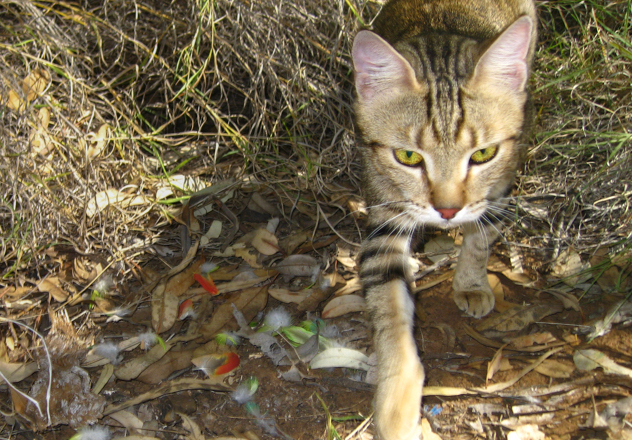The Eastern Bandy-bandy snake (Vermicella annulata) is one of six species within the Vermicella genus and is particularly striking as a result of their distinctive black and white banding pattern. While they are globally considered a species of Least Concern, there have been local population declines due to feral predation in South Australia and Victoria, prompting higher risk conservation statuses. While AWC isn’t currently implementing any direct conservation measures, many of the Eastern sanctuaries protect important habitat for this species.

 Wayne LawlerAWC
Wayne LawlerAWC
The Eastern Bandy-bandy snake, due to its national conservation status of least concern, it not the focus of any direct conservation measures. However, several of AWC’s sanctuaries protect important habitat within the species’ range including Bowra and The Pilliga in NSW, and even on the Cape York Peninsula at Piccaninny Plains Wildlife Sanctuary.
 © AWC
© AWC
While this species is considered to be one of Least Concern on the IUCN Red List as a result of its wide distribution and thus adaptability to a range of habitats and environmental conditions, populations in South Australia and Victoria are considered Rare and Endangered respectively.
The impact of feral predators is the most likely cause of this status. While several native species predate on the Eastern Bandy-bandy snakes including owls and reptiles, the biggest threat to this species is feral cats and foxes. They are particularly vulnerable due to their lack of camouflage ability.

Description
The Eastern Bandy-bandy snake has a distinct pattern of alternating black and white bands down the length of their body which create a flicker fusion effect when the snake moves quickly in dim light. As a defence strategy, this aims to confuse predators and reduce the chances of them becoming prey. Additionally, their striped colouration is thought to have an aposematic function, an evolutionary development that warns predators of potential venomous defences.
Their scales are smooth and glossy, and adults can grow to 60cm in length however females tend to be larger, averaging 54cm while the mean male size is just 39cm. As with other snakes in the Elapidae family, the Eastern Bandy-bandy snake has one pair of fixed fangs designed to deliver toxins to their prey or as a defence strategy, however relative to other species in the Vermicella genus, Vermicella annulata is considered least venomous to humans due to its small bite and often only localised symptoms occur around the bite.
In comparison to other Vermicella species, Vermicella annulate tends to have fewer ventral scales and a wider body. Interestingly, the mean adult body size decreases with in closer proximity to the equator. This is to say that species found in the most southern parts of the largest, a trend that is opposite to other Australian elapid snakes such as Psudechis australis that shows a decreasing mean adult body size with increasing latitude.
Ecology
It is very rare to see a Eastern Bandy-bandy snake due to their highly secretive nature. Indeed, they are fossorial, adapted to burrowing and living primarily but not solely underground, and are also nocturnal. The best time to glimpse one on the surface is at night during summer and autumn after a period of heavy rain. They can also be seen involved in a defensive display, raising one or more loops of their body into the air while keeping their tail and head grounded, to dissuade predators by exaggerating their height and colouration to appear more intimidating.
Intriguingly, Eastern Bandy-bandy snakes are ophiophagous, feeding almost exclusively on Blind Snakes and specifically, the species Ramphotyphlops nigrescens. Several studies have confirmed this through modifying the available prey sources and demonstrated that Eastern Bandy-bandy snakes consistently preferentially select Blind Snakes as their food source. They hunt using chemical cues collected through their tongue flicking.
Breeding occurs between October and February and being an oviparous species, females lay eggs that subsequently hatch. Their clutch size tends to correlate strongly with the body size of the female whereby larger females lay a greater number of eggs however on average, they tend to be between 2 and 13 eggs. After hatching, males mature first at approximately 2 years, followed by females a year later.
Range and Abundance
The Eastern Bandy-bandy snake has one of the widest distributions of snake species and is the most wide-ranging taxon in the Vermicella genus. Their extent ranges from Shepparton in northern central Victoria, west to Port Augusta and north along the eastern coast up into Cape York and west into sections of Arnhem Land. As a result of this distribution, they are adaptable to several habitat types including rainforests, spinifex grasslands, savannas, and shrublands.
Donate to help protect species such as the Eastern Bandy-bandy Snake
Donate NowBrooklyn Sanctuary supports a greater diversity of wildlife than any other single property in Australia. It protects an incredible variety...
Representing a landmark collaboration between AWC and the NSW National Parks and Wildlife Service, the Pilliga project area protects a...
Piccaninny Plains lies in the heart of Cape York Peninsula, a region of global significance for conservation. Covering almost 165,000...
The Purple-crowned Fairy-wren is a small social bird found in dense riparian vegetation in northern Australia.
In regions where Common Brushtail Possum are rare, AWC protects them at its sanctuaries and partnership areas.
AWC protects three populations of Northern Quoll and their habitat on a number of our northern sanctuaries.